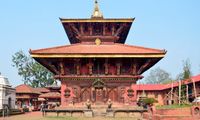Bhaktapur Durbar Square
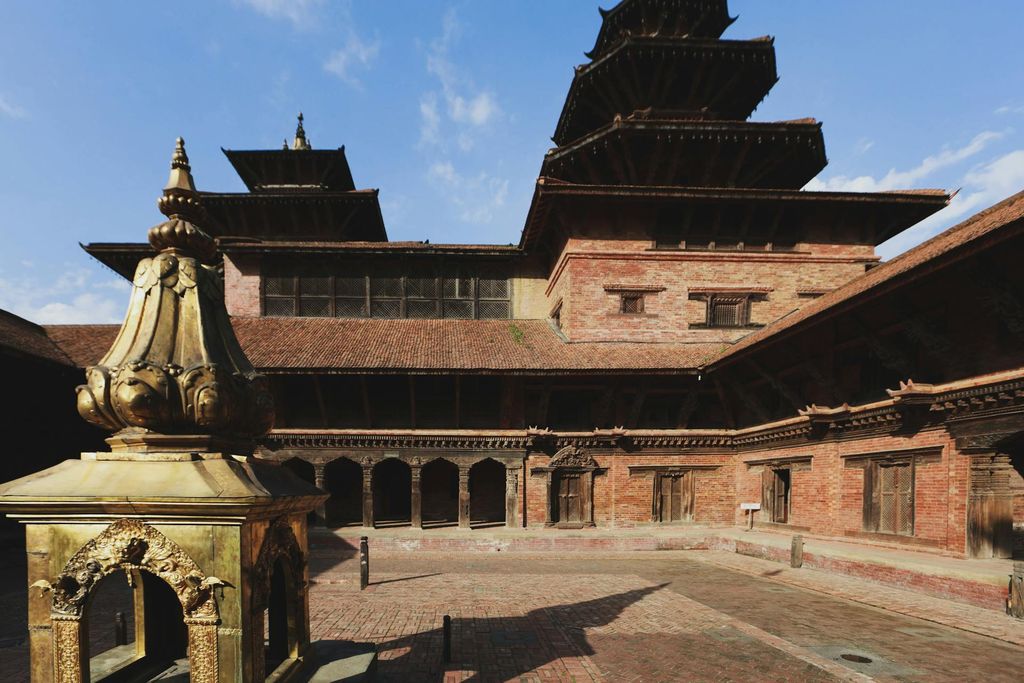
About
Bhaktapur Durbar Square consists of an elegant space and open surrounding covered with buildings facing toward the south direction dating from 13th century to 18th century. Located in Bhaktapur, the third largest city in Kathmandu Valley, this site is enlisted in UNESCO World Heritage Site attracting foreigners from all over the world.
It is believed that this durbar square was built during the reign of Malla dynasty. The square was the royal place for Malla Kings and also the central power during their ruling tenure. The fascinating architectural design carries different cultural importance besides its historical and archeological significance. It is regarded as the homeland for its vibrant Nepalese culture and hub for many socio-cultural events celebrated throughout the year.
Locate Us
Nearby Attractions
Bhaktapur Durbar Square is one of the World Heritage Sites of UNESCO, It is located in Bhaktapur Municipality of Bhaktapur District, about 13 km east of Kathmandu. This was the palace complex of the Malla kings (12th–18th century) and still a living museum of Newar art, culture, and architecture. The square is filled with red-brick courtyards, intricate woodwork, and stone sculptures of Nepal's medieval grandeur.
A few of the key attractions include the 55-Window Palace, built by King Bhupatindra Malla in 1754, and the Golden Gate, a masterwork in repoussé. The Vatsala Temple, with its stone building and giant bronze bell, the holy Taleju Bhawani Temple, and the elegant National Art Gallery all add to the ancient beauty. Taumadhi Square, which is close by, houses the five-story Nyatapola Temple, Nepal's highest pagoda, and Dattatreya Square is famous for its very old woodcarvings and the famous Peacock Window.
You can start the day with sunrise at Nyatapola Temple and proceed to visit the 55-Window Palace and National Art Gallery. Take a mid-morning snack of the tasty local yogurt, "juju dhau," and proceed to Pottery Square to watch artisans at work. Take lunch at a rooftop cafe with views of the square, then stroll to Dattatreya Square to see traditional houses and hidden courtyards. End the day with sunset views at Siddha Pokhari, a peaceful historic pond.
Bhaktapur is perfect for laid-back get-togethers in charming rooftop eateries and tea houses that offer valley-wide views. The city's cuisine shines with Newari Bara (lentil patties), Samay Baji (festival plate), and locally brewed Aila (rice liquor). Major festivals such as Bisket Jatra fill the streets with chariot processions, music, and vibrant dances, testifying to profoundly entrenched traditions.
With its holy temples, vibrant squares, and traditional flavors, Bhaktapur Durbar Square provides an unforgettable exploration of Nepal's medieval past and rich Newar culture—in just one rewarding day.
Best Places to Visit In and Around Bhaktapur
Walking around Bhaktapur is like returning to a golden era of art and worship. Only a short ride from Kathmandu, this ancient city of the Newars is full of ageless courtyards, elegant temples, and streets still ringing with the beat of ancient festivals. There's something extraordinary around every bend—whether it's an enclosed courtyard redolent with incense or an artisan sculpting clay vessels as his forefathers did centuries before.
The city's central piece is Bhaktapur Durbar Square, where the massive 55-Window Palace and the dazzling Golden Gate attest to the skill of Newar wood- and metal-workers. In the palace compound you can see Basantapur Chowk, the serene Bhandarkhal Garden, and the fascinating National Art Museum, all tales of the great Malla kings who once ruled here.
For culture seekers and pilgrims, the religious side of Bhaktapur is also fascinating. Rock idols like sculptures of Ugrachandi and Ugra Bhairava, preservative statues of Narasimha and Hanuman, and lovely Vatsala Durga and Siddhi Laxmi Temples all have centuries worth of religious meanings. Don't miss the city's own Char Dham Temples—miniature versions of India's great pilgrimage centers such as Badrinath, Jagannath, Rameshwor, Radhakrishna, and Kedarnath—which permit pilgrims to pay homage to these deities without leaving the valley.
Bhaktapur's way of life is equally irreparable. Catch the morning ceremonies at the Kumari House, home of the living goddess, or visit during Bisket Jatra or Indra Jatra, when chariots rumble down the streets accompanied by music and cheers. Between sites, treat yourself to a bowl of creamy juju dhau (king curd) or a plate of Newari samay baji in one of the rooftop restaurants above the square.
From towering pagodas to hidden shrines, every site in Bhaktapur combines history, spirituality, and everyday life, giving visitors an authentic look at Nepal's rich cultural center.
55-Window Palace
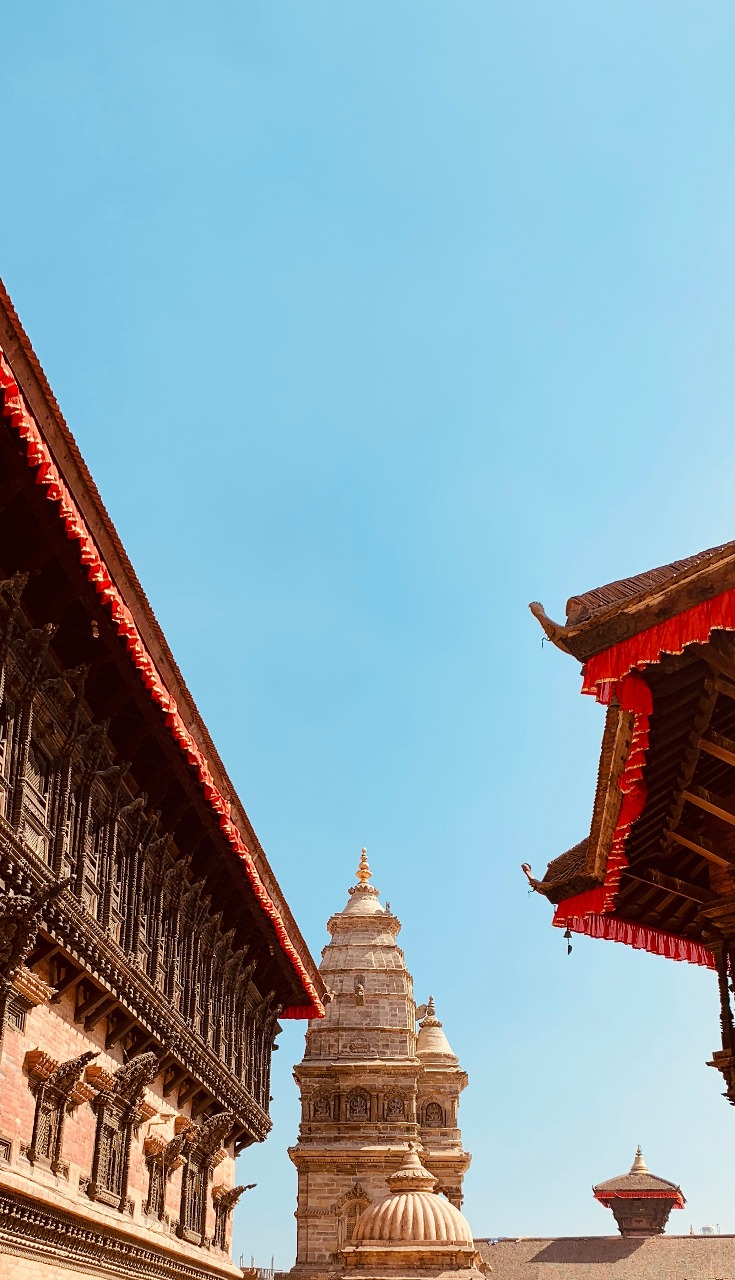
Centering Bhaktapur Durbar Square is the stunning 55-Window Palace, built in 1754 by King Bhupatindra Malla. The three-story royal palace is famous for its fifty-five intricately carved wooden windows—each one a masterpiece of Newar craftsmanship. The palace was the residence of the Malla kings and political and cultural hub of Bhaktapur. Today, it is the finest example of Malla-period architecture and a must-visit for history buffs and photographers.
Basantapur Chowk
Within the palace grounds is Basantapur Chowk, a ceremonial courtyard in which royal ceremonies and state rituals took place. Intricate wood and stone carvings border the courtyard and reflect the artistic decadence of the Malla era. Tourists can get the essence of medieval Nepal as they walk through this sacred royal grounds.
Sculptures of Ugrachandi and Ugra Bhairava
Before the Golden Gate are two dramatic 17th-century stone figures—Ugrachandi, the fierce power goddess, and Ugra Bhairava, a wrathful form of Lord Shiva. The sculptor was supposedly ordered to be executed so such realistic sculpture would never again be created, contributing to their unmatched singularity. They symbolize divine protection and are quintessential examples of traditional Newar stone carving.
Char Dham Temples of Bhaktapur
Bhaktapur has smaller-scale copies of India's four sacred pilgrimage sites, so that pilgrims can worship the Char Dham without venturing far:
- Badrinath Temple – Dedicated to Lord Vishnu, in the style of a North Indian pagoda architecture.
- Jagannath Temple – Renowned for ornate wood carving and vibrant festivals.
- Rameshwor Temple – A Shiva temple symbolizing spiritual balance and piety.
- Radhakrishna Temple – Celebrating the immortal love affair of Radha and Krishna, sacred to Vaishnav worshippers.
- Kedarnath Temple – Symbol of the Himalayan residence of Shiva, which has maintained traditional Newar rituals.
They are all testimonies to Bhaktapur's balanced fusion of Hindu faith and indigenous skill.
Bhandarkhal Chowk
A serene courtyard at the back of the palace, Bhandarkhal Chowk was originally used to keep royal treasures and has a historic water tank within a verdant royal garden. It speaks of the sophisticated water-management systems and garden design of the Malla dynasty.
National Art Museum
Situated in a wing of the 55-Window Palace, National Art Museum conserves Nepal's heritage. The National Art Museum exhibits Paubha (Newar Thangka) paintings, manuscripts dating back to centuries, and stone sculptures dating back to the Licchavi and Malla periods. Art lovers can examine fine iconography and realize how Newar artists shaped Himalayan art traditions.
Statues of Narasimha and Hanuman
Guards of the palace grounds, these statues are dedicated to Narasimha, the lion-man incarnation of Vishnu, and Hanuman, the monkey god. Both icons of bravery, loyalty, and divine, they hold a significant role in Bhaktapur's religious activities.
Golden Gate
The breathtaking Sun Dhoka or Golden Gate is one of the most beautiful gateways in Asia. It was commissioned in the 18th century by King Ranjit Malla, and its gild-copper repoussé work shows Hindu gods like Kali and Garuda. The ornamented entrance leads to the inner palace courtyard and is the pinnacle of Newar metalwork.
Statue of King Bhupatindra Malla
Before the Golden Gate is the stunning statue of King Bhupatindra Malla, in prayerful posture atop a tall pillar. It was constructed to pay tribute to the king's faith and his efforts in bringing about the golden era of art and architecture of Bhaktapur.
Vatsala Durga Temple
The stone-built Shikhara-style Vatsala Durga Temple is dedicated to Goddess Durga. It's famous for the "Bell of Barking Dogs," whose sound is said to drive dogs into frenzied barking. It is both an architectural gem and a place of local pilgrimage.
Siddhi Laxmi Temple
This multi-level pagoda is in honor of Goddess Siddhi Laxmi, a tantric deity. The temple is guarded by human, lion, and elephant stone figurines—representatives of power and safeguarding of the soul. Its carving is one of the highlights for tourists interested in Newar religious art.
Kumari House (Tadhuchhen Bahal)
The Kumari House is located in the center of Bhaktapur's tradition of living goddess. Beyond its elaborately carved wooden facade lives the Kumari, a young girl who is revered as the living personification of Goddess Taleju. Rituals and festivities here preserve centuries-old religious practices unique to the Newar people and remain a living heritage of Bhaktapur.
Cultural Significance and Living Heritage
Bhaktapur Durbar Square is more than a collection of monuments—it is a living heritage site where Newar culture, Hindu and Buddhist tradition, and centuries-old festivals continue to flourish. Festivals such as Bisket Jatra, with its dizzying chariot processions, and Indra Jatra, with its masked dances and holy rituals, bring the squares and courtyards to life. Local craftsmen continue to make pottery, wood carvings, and metalwork using ancient methods, which preserves the authenticity of Bhaktapur's artistic heritage.A UNESCO World Heritage site, Bhaktapur Durbar Square is Nepal's best-preserved medieval city, offering visitors an untainted excursion into actual Nepali history, architecture, and spirituality. From indulging in the iconic juju dhau (king curd) to participating in centuries-old festivals, visitors experience the actual essence of Nepal's cultural soul.
Local foods found in Bhaktapur
Bhaktapur is Nepal's gastronomic treasure, famous for its centuries-old intact Newari cuisine. Any visit to Bhaktapur Durbar Square is incomplete without tasting its famous local food, which is not just food but an epitome of culture, history, and ritual. The city food is symbolic of Newar's addiction to rich flavor, balanced texture, and symbolic presentation and thus, Bhaktapur is paradise for foodies and culture lovers too.
Juju Dhau (King Curd)
presumably the most famous dish of Bhaktapur, Juju Dhau, or "King Curd," is creamy, full yogurt made from top-quality buffalo milk. It is served in clay pots, which have the effect of maintaining its thick, silky consistency and adding a subtle earthy aroma. Juju Dhau is naturally sweet and faintly tangy and is thus a dessert that cannot be resisted. It is traditionally enjoyed by visitors after lunch or during festive occasions, where it is presented as a symbol of prosperity and Bhaktapur's pride of the dining table.
Samay Baji
Samay Baji is a ceremonial platter that showcases the abundance and variety of Newari food. The platter has beaten rice (baji), marinated grilled meat, lentil patties, boiled eggs, pickles, and fried vegetables. Every item is culturally and spiritually meaningful: for instance, baji represents purity, and meat and lentils are symbols of strength and prosperity. Samay Baji is traditionally prepared on Dashain, Tihar, and other religious occasions, hence it becomes a culinary delight and a cultural experience.
Chatamari (Newari Pizza)
Commonly known as the "Newari pizza," Chatamari is a thin rice flour crepe stuffed with a variety of fillings, such as ground meat, eggs, vegetables, or cheese. It is commonly served from roadside eateries near Bhaktapur Durbar Square and is widely used as a street food. The crispy edges paired with soft fillings make it an excellent street food for travelers exploring the city. Chatamari also plays a role in festivities and communal events, symbolizing sharing and celebration in Newar culture.
Bara (Lentil Pancakes)
Bara is a fried spiced lentil pancake that is consumed as a celebratory dish and also as a snack. It is prepared using ground black lentil, and the dish is typically accompanied by tomato achar or sesame chutney, which adds taste and richness. Bara is prepared on ritual occasions, family gatherings, and festivals like Yomari Punhi, and illustrates the Newar people's love for protein-rich food.
Yomari (Sweet Dumplings)
Yomari is a steamed dumpling made of rice flour dough and molasses, sesame seeds, or coconut. Traditionally prepared during the Yomari Punhi festival, Yomari symbolizes harvest, prosperity, and thanksgiving. Yomari is a dessert as well as a cultural icon through which tourists can indulge in the age-old tradition.
Choila (Spicy Grilled Meat)
Choila is a traditional Newari dish made of spiced, grilled buffalo or chicken meat. It is normally accompanied by beaten rice and achar, Choila is renowned for its smoky flavor and strong spices. Choila is a festival, wedding, and communal celebration favorite, reflecting the Newar penchant for celebrating through food.
Kwati (Mixed Bean Soup)
Kwati is a nutritious soup made using nine different sprouted beans and is especially eaten on the occasion of Gun Punhi, the festival of sprouts. This nutritious food is a symbol of virility and good health and is eaten as a common food during winter days. It is made and eaten with ritual entering into every activity, emphasizing food and custom in Bhaktapur.
Thwon (Traditional Fermented Drink)
Thwon is a locally brewed drink, locally fermented from millet or rice in the local locale. It is usually taken during festivals, religious events, and social gatherings. Thwon is a part of Newari protocol and is thought to be both a ceremonial offering and a community drink and hence suggestive of Bhaktapur's social and spiritual life.
Lakhamari and Other Sweets
Lakhamari is a sweet pastry fried, shaped, and sugared or spiced and traditionally served at weddings and ceremonies. Chhwe Chhwe, rice flour sweets, are also reportedly exchanged at family gatherings and festivals. These sweets are not just tasteful but also carry ritual connotations and thus contribute to the spiritual and cultural identity of the city.
Aila (Traditional Rice Liquor)
Aila is a strong rice or millet alcohol which is usually consumed on festivals and ceremonies. It is served in rituals and offered before the gods during traditional Newari rituals. Its preparation, consumption, and sharing of Aila denote hospitality and continuity of culture in Bhaktapur society.
Why are Bhaktapur's Local Foods Unique?
Bhaktapur cuisine is more than food—it's a living cultural symbol. Enjoying the creamy Juju Dhau, savoring the hot Choila, or participating in a celebratory Samay Baji ritual, travelers visit to be surrounded by centuries of Newar tradition, craftsmanship, and communal life. In the community of Bhaktapur Durbar Square, foods are offered in street stands, local dining halls, and family homes so that visitors may taste both culinary heritage as well as daily Newari culture.
Tasting these dishes is an experience that touches multiple senses—from the scent of spices to the visual appeal of presentation and the ceremonial nature of each dish. For anyone traveling to Bhaktapur, sampling its local dishes is as integral a part of the experience as seeing its temples, palaces, and cultural monuments, providing a comprehensive and genuine experience of Nepal's living culture.
Arts and culture of bhaktapur
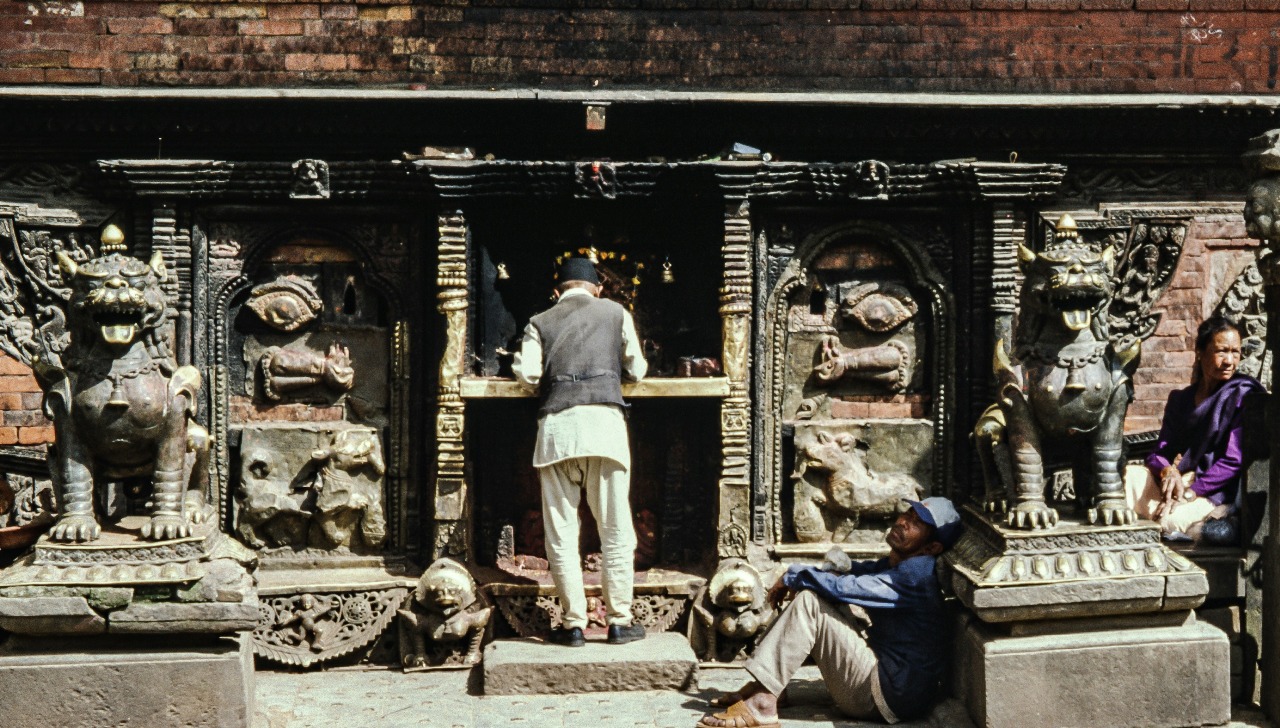
Bhaktapur Durbar Square is not merely an historical monument—it is the very heartbeat of Nepal's cultural and artistic life. Located in Bhaktapur Municipality of Bhaktapur District, the UNESCO World Heritage Site evokes the splendor of the Malla period architecture, old Newar craftsmanship, and the ancient spiritual tradition. Strolling through the square, travelers are immediately taken to another world where temples, palaces, and statues tell stories of spirituality, royalty, and craftsmanship that have been preserved for over 500 years.
Newar Architecture and Craftsmanship
At the center of Bhaktapur Durbar Square lies the legendary 55-Window Palace, a wonder built by King Bhupatindra Malla. Each window of its own is decorated with intricate motifs of gods, mythical creatures, and geometric designs, the best of Newar woodcraft. The palace is surrounded by temples and shrines with pagoda-topped roofs, stone carvings, and metal repoussé, especially found in the Golden Gate (Sun Dhoka), which is also considered among Asia's most beautiful metal gates. The coexistence of wood, stone, and metal sculptures in Bhaktapur induces a synthesis of harmony in aesthetics, religiousness, and historical storytelling.
Sculpture and Stone Art
The square itself is punctuated by beautiful stone sculptures that are both religious and artistic in nature. The Sculptures of Ugrachandi and Ugra Bhairava near the Golden Gate symbolize fierce divine protection, while statues of Narasimha and Hanuman guard the palace grounds and reflect courage and dedication. The Vatsala Durga and Siddhi Laxmi temples feature exquisite stone guardians in elephant, lion, and human shapes, reflecting the Newar dedication to spiritual symbolism in art.
Paubha Paintings and Museum Collections
Bhaktapur Durbar Square is the hub of Paubha painting, the traditional Newar scroll painting that has its origins before Tibetan thangka painting. The paintings depict Hindu and Buddhist gods with unimaginable detail and symbolism. Most of these pieces are kept in the National Art Museum, within the 55-Window Palace complex, where the public can view centuries-old pieces and enjoy the richness of Nepalese artistic heritage.
Festivals, Music and Dance
The arts of Bhaktapur are not petrified in time—instead, they are practiced and performed daily in the form of festivals, dance, and music. Festivals such as Bisket Jatra, Indra Jatra, Dashain, and Gai Jatra animate the square with chariot processions, masked dances, devotional singing, and traditional Newar instruments such as dhime drums and cymbals.
They animate the monuments and courtyards of Bhaktapur Durbar Square, allowing tourists to experience centuries-old ritual and cultural practices that continue to be deeply rooted in local identity.
Pottery and Traditional Crafts
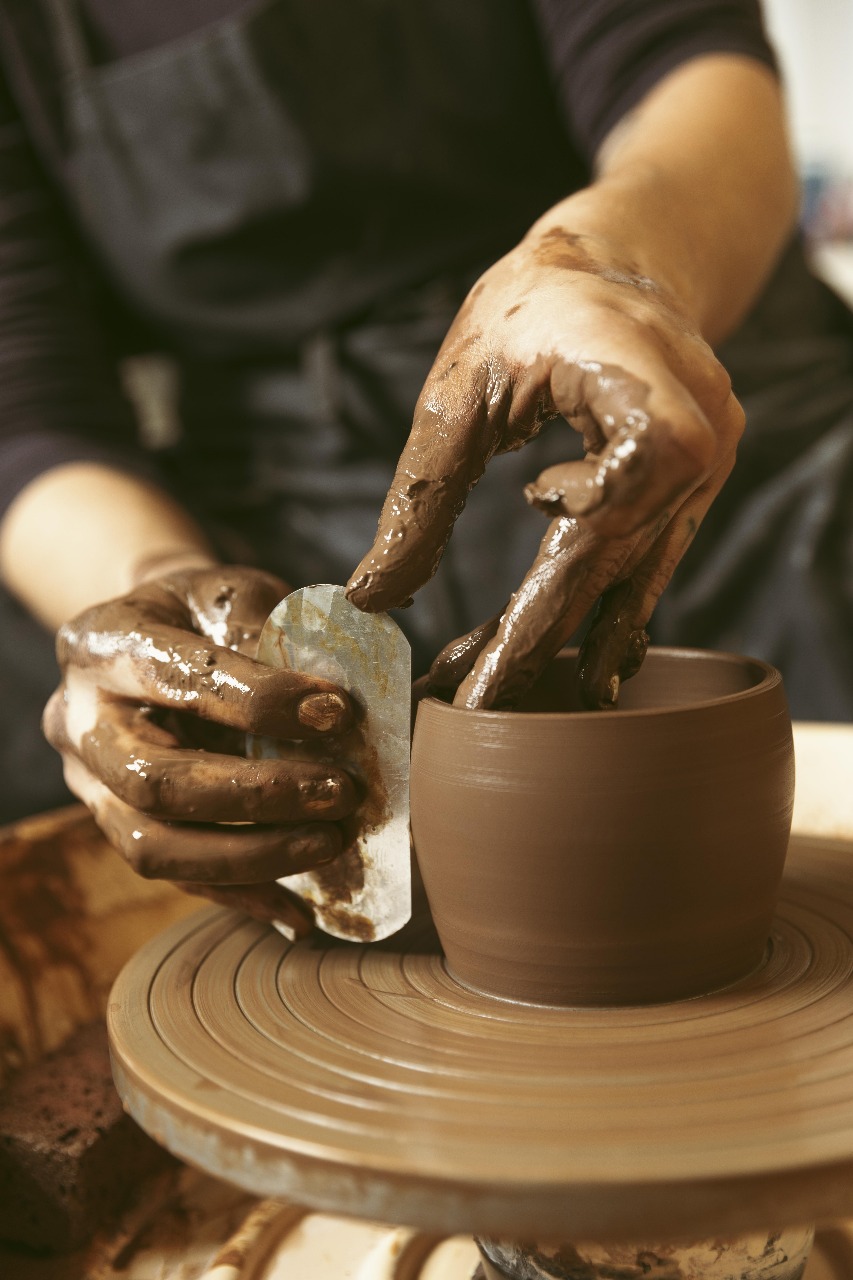
Nearby Pottery Square continues the city's tradition of craftsmanship. Artisans shape clay on spinning wheels to create ceremonial urns, water jars, and decorative lamps—a tradition that dates back centuries. Watching these artisans, tourists are treated to the mundane artist's existence that rounds out the pomp of Bhaktapur Durbar Square.
Spiritual and Cultural Significance
There is spiritual and cultural significance everywhere in Bhaktapur. The Kumari House (Tadhuchhen Bahal), home of the living goddess, represents the city's ongoing Newar religious customs. The Char Dham temples, miniature representations of India's sacred pilgrimage centers, allow followers to experience the subtleties of holy Hindu ceremonies in the city. Together, these locations illustrate why Bhaktapur Durbar Square is not merely a tourist attraction—it is a center of living art, devotion, and Newar tradition.
Festivals Celebrated in Bhaktapur
Bhaktapur is a city where culture, religion, and tradition come alive through its vibrant festivals. Known as the living museum of Newar culture, the city celebrates numerous events throughout the year, attracting both locals and tourists. These festivals showcase Bhaktapur’s rich Hindu and Buddhist heritage, age-old rituals, and communal spirit.
Bisket Jatra
One of the most famous festivals in Bhaktapur, Bisket Jatra marks the Nepali New Year and usually falls in mid-April. The festival is celebrated with grand chariot processions, traditional music, and lively dances. Huge wooden chariots carrying the idols of Bhairava and Bhadrakali are pulled through the city streets by crowds of devotees, creating a unique spectacle that reflects centuries-old Newar traditions.
Indra Jatra
Although more famous in Kathmandu, Indra Jatra is also celebrated in Bhaktapur with masked dances, devotional songs, and religious rituals. The festival honors Indra, the god of rain, and showcases the deep integration of Hindu mythology and Newar performance art.
Dashain
Dashain, Nepal’s longest and most important festival, is widely celebrated in Bhaktapur. It is a time for family gatherings, worship, and traditional rituals. Temples across the city, including those in Bhaktapur Durbar Square, are adorned with flowers and offerings, and devotees receive tika and jamara from elders.
Tihar (Festival of Lights)
Tihar, also known as Deepawali, brings Bhaktapur to life with illumination, decorations, and rituals honoring gods, animals, and ancestors. Special attention is given to Lakshmi Puja, and streets are filled with oil lamps, flowers, and rangoli patterns, showcasing the city’s vibrant Newari cultural identity.
Gai Jatra
Celebrated in memory of deceased family members, Gai Jatra is marked by processions, colorful costumes, and satirical performances. In Bhaktapur, it blends mourning with humor, reflecting the city’s unique approach to life, death, and community solidarity.
Yomari Punhi
A harvest festival dedicated to the Newar community, Yomari Punhi celebrates the rice harvest with Yomari, steamed sweet dumplings, traditional dances, and cultural rituals. It highlights the city’s agricultural roots and culinary traditions, linking food and culture.
Other Local Festivals
Bhaktapur also celebrates smaller festivals such as Sithi Nakha, Ghode Jatra, and Chyasa Puja, each reflecting the city’s devotion, communal harmony, and rich artistic traditions.
Visiting Bhaktapur during these festivals allows travelers to experience the city at its most colorful and vibrant, where temples, squares, streets, and courtyards come alive with music, dance, and rituals, offering an authentic glimpse into Newar heritage and Nepalese culture.
Major Ethnicity of Bhaktapur
The Newar people constitute the majority population of Bhaktapur, and they are the native people of the Kathmandu Valley. The Newars possess a distinct culture, traditional art and handicrafts, majestic festivals, and unique cuisine. The city is also populated by smaller numbers of Brahmins, Chhetris, Tamangs, and other groups, which makes it culturally rich.
The Newar people, nonetheless, still make up the essence of Bhaktapur's identity since they are the principal custodians of the city's art, architecture, festivities, and cuisine, especially in Bhaktapur Durbar Square.
What is Bhaktapur Famous For?
Bhaktapur is famous for its rich heritage, historic architecture, traditional arts, and authentic Newari way of life. Among the principal attractions include:
- Bhaktapur Durbar Square – A UNESCO World Heritage Site, where the 55-Window Palace, Golden Gate, and numerous historic temples are located.
- Newar Art and Architecture – Intricate woodcarvings, metalwork, stone sculptures, and traditional courtyard planning.
- Festivals and Rituals – Bisket Jatra, Indra Jatra, Dashain, and Yomari Punhi are some festivals and rituals that provide glimpses of local traditions.
- Cuisine – Juju Dhau, Samay Baji, Chatamari, Bara, and Yomari are some of the well-known foods.
- Pottery and Crafts – Traditional potteries at Pottery Square and handcrafted souvenirs.
- Living Culture – Home to the Kumari (living goddess) tradition and continuing Hindu-Buddhist rituals.
Bhaktapur is also famous for its well-preserved medieval streets, ancient temples, and unique festivals, which attract cultural tourists, history enthusiasts, and photographers from all over the world.
How to Get to Bhaktapur from Kathmandu?
It is easy, convenient, and suitable for any type of traveler, whether you are a solo tourist, traveling with family, traveling in groups, or educational tours.
By Car or Taxi
Bhaktapur lies only 13 km from downtown Kathmandu, and driving takes 30–45 minutes depending on traffic. Taxi or private car hire is best for family vacations, group tours, or picnic daytrips, providing comfort, convenience, and a scenic tour through suburban villages and towns. Private transport is also suitable for history or cultural study tours, where travelers can halt at important points along the way.
By Local Bus
Local buses and microbuses run regularly from Gongabu or Bagbazar bus stops or Ratnapark bus station. The journey takes about 45–60 minutes and is a cheap way to travel in groups, school excursions, or easy day trips. Traveling on the bus also offers tourists an insight into daily life in the Kathmandu Valley.
Tips for Group and School Tours
Reserve early to avoid traffic, particularly during the festival season.
Book advance taxis or buses for groups or guided tours.
Drop off near Bhaktapur Durbar Square to have maximum time to visit temples, palaces, museums, and local markets.
Recommended for picnics, photography tours, or study tours of history and culture.
Whether purpose—tourism, group travel, education, or recreation—it is easy to arrive in Bhaktapur from Kathmandu, to have a relaxing enjoyment of the city's heritage, architecture, culture, and cuisine in one trip.
Hotels in Bhaktapur
Bhaktapur boasts various accommodations, ranging from heritage guesthouses to boutique hotels, so it is convenient for travelers coming to Bhaktapur Durbar Square and other attractions. These are some of the most popular hotels:
- Hotel Heritage Bhaktapur – A heritage hotel that maintains traditional Newari architecture with modern amenities.
- Bhaktapur Boutique Hotel – Good rooms, close to Durbar Square, and nearby local bazaars.
- Hotel Dwarika's Bhaktapur – Cozy accommodation with authentic Newari architecture, upscale dining, and serene environment.
- Bhaktapur Guest House – Economical, clean, and ideal for backpackers and solo travelers.
- Hotel Shree Mahal – Contemporary amenities and close to popular sites like temples and museums.
- Kathmandu Guest House Bhaktapur – Cozy living space with a mix of traditional and modern interiors, ideal for families.
- Hotel Heritage Inn – Offers panoramic city views of Bhaktapur Durbar Square and rooftop dining.
- Ganesh Himal Hotel – Affordable rooms with convenient proximity to Pottery Square and native restaurants.
- Hotel Royal Singi – Quiet and comfortable lodging, ideal for tours of historical landmarks and local culture.
- Bhaktapur Residency – Affordable hotel with spacious rooms, quality accommodations, and temple and square proximity.
Conclusion
Bhaktapur is a wide-open, outdoor museum of Nepalese culture where history and art, festivals and cuisine are intertwined. The essence of the city, Bhaktapur Durbar Square, showcases splendid Malla-era architecture, intricately carved wood, slender temples, and mythical landmarks including the 55-Window Palace and Golden Gate.
The Newar culture of the city comes alive in the guise of vibrant festivals such as Bisket Jatra, Dashain, and Yomari Punhi, and traditional food like Juju Dhau, Samay Baji, Chatamari, and Bara offers one a glimpse of authentic culinary art. One may go temple-hopping, museum-hopping, bazaar-hopping, or visit Pottery Square, or stay in heritage hotels that are an extension of the city's rich beauty.
Bhaktapur is not somewhere to go to—Bhaktapur is an experience, an opportunity to see centuries of tradition, spirituality, and artistic excellence that render the city one of Nepal's most valuable gems.
FAQ of Bhaktapur Durbar Square
Where is Bhaktapur Durbar Square located ?
The center of Bhaktapur city, roughly 13 kilometers east of Kathmandu, Nepal, is home to Bhaktapur Durbar Square. Famous for its magnificent medieval architecture and rich cultural legacy, this historic royal square is recognized as a UNESCO World Heritage Site.
Why is Bhaktapur Durbar Square famous?
Nepal's crown jewel, Bhaktapur Durbar Square, is well-known for its magnificent historical structures, profound religious importance, and dynamic living culture. It is a UNESCO World Heritage Site that features magnificent palaces, elaborate wood carvings, and ancient temples. Its spiritual core is emphasized by the revered Nyatapola and Bhairav temples. As you explore this ageless city where culture and history coexist, don't miss the opportunity to sample Juju Dhau, also known as the "king of yogurts," a representation of Newari tradition!
What is the best time to visit ?
The finest seasons to visit Bhaktapur Durbar Square are October through December in the fall and February through April in the spring, when the city is alive with events like Dashain and Bisket Jatra. Avoid the June–August monsoon season for better exploring and cleaner skies.
How do I reach Bhaktapur Durbar Square from Kathmandu?
From Kathmandu, you can take a taxi (30–40 minutes) or a local bus (1 hour) from Ratna Park or Koteshwor to Bhaktapur Durbar Square. As an alternative, use a motorbike or rent a private vehicle for the picturesque 13-kilometer journey east.
What are the best places to visit ?
Best Places to Visit in Bhaktapur Durbar Square:
- The 55-Window Palace: An architectural masterpiece from the Malla period.
- Nyatapola Temple: Dedicated to Siddhi Lakshmi, this five-story pagoda is the tallest in Nepal.
- Tantric traditions are associated with the fierce yet revered Bhairavnath Temple.
- The Sun Dhoka's Golden Gate is a magnificent golden entrance with elaborate sculptures.
- Vatsala Temple: renowned for its statues of lions and stone bells.
- Outside of Durbar Square:
- The Nyatapola and Bhairavnath temples are located in Taumadhi Square.
- Pottery Square: See craftspeople use age-old methods to create clay pots.
- Dattatreya Square: historic temples and the Peacock Window, a wonder of woodcarving.
- Nearby Changu Narayan Temple is Nepal's oldest Hindu temple and a UNESCO World Heritage Site.
- Local Cuisine: Sample the king curd (juju dhau) and the lentil pancake (bara) in neighborhood restaurants.
Is Bhaktapur Durbar Square safe for solo travelers ?
Yes, Bhaktapur Durbar Square is safe for lone tourists as long as they keep their possessions safe, avoid secluded spots at night, and remain vigilant in crowds. Exploring during the day is really comfortable, and the locals are kind!
